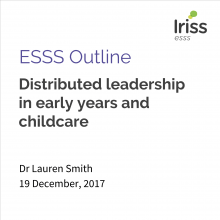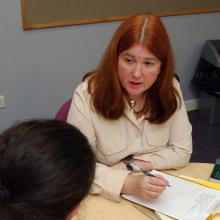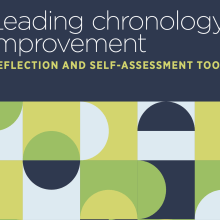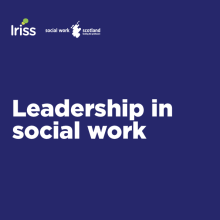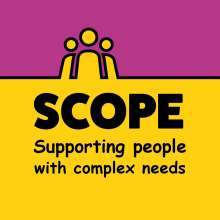This case study is based on the key findings of research undertaken within Angus Council Social Work and Health (Deacon, 2011), which asked the question - how good is our leadership?
It outlines the journey undertaken by Angus Council Social Work and Health. We review the national context of leadership and offer a local perspective of the route taken to explore, examine and develop leadership within a local authority context. We will also incorporate current research, new developments and resources developed by the Scottish Social Services Council (SSSC) which offer a comprehensive leadership capabilities framework for further leadership development work across the social services workforce.
Our key reflections and findings are:
- Leadership means different things to different people, but evidence links the importance of leadership to organisations and to effective service delivery
- To address future and ongoing challenges in the social care sector, a one size 'hero' leader who leads solely from the top, will not work
- Leadership growth requires resources and an organisational culture which supports innovative and creative ways of developing and harnessing the skills and knowledge of the wider workforce
The issue of leadership
Increasing demands are being placed on our public sector services through the current global climate of financial constraints and the culture of constant change, both of which influence direction. The need for effective leadership has become ever more acutely emphasised. Hearts and minds inevitably turn to 'leaders' for solutions that will identify clear pathways through the challenging times that lie ahead. Since the research was carried out in Angus, the new integration agenda set out by Scottish Government (2012) has come into focus. In the report, Nicola Sturgeon, Deputy First Minister and Cabinet Secretary for Health and Wellbeing, (2012, p 2) emphatically points out that we cannot "rest on earlier successes". Implementation of integration will even more strengthen the case for effective leadership to underpin change management.
'Transformation of social work services to better meet people's needs requires major cultural change, as well as visionary leadership at national and local levels.'
(Changing Lives 2006)
Through Changing Lives,(2006), the Scottish Government set out the need for change and the essence of the report highlighted the need for partnership working at all levels to ensure the best possible outcomes for people who use our services. Changing Lives also clearly evidenced strong links between effective service delivery and the existence of leadership within a learning organisation. However, the report cautioned that there was little evidence linking the demonstration of effective leadership and positive service outcomes, highlighting that further work around the usefulness of leadership was required.
Further work, including social work inspections across Scotland confirmed links between effective leadership and outcomes. The Social Work Inspection Agency (SWIA) published a report - Improving Social Work in Scotland (SWIA, 2010). This too confirmed the importance of leadership in relation to outcomes for people who use services, as well as staff morale.
Current findings from the research project, 'Leading Together' (University of Stirling, 2010), also corroborated the importance of leadership at all levels as a key contributor to effective practice within the workplace. As a result of this project and consultation with the sector, the Scottish Social Services Council's (SSSC) vision is to develop effective leadership at all levels within the workforce, including strong citizen leadership.
At a local level Angus Council was in the midst of an internal and external inspection period (SWIA/SCSWIS 2009). This triggered an opportunity for us to investigate our leadership capacity and culture in order to achieve a clearer vision of how our own brand of leadership could support the development of our workforce.
What we did
Our journey began in 2010 when we asked three inter-related questions about Angus Council Social Work and Health department, which we will continue to explore here:
- What difference is leadership making?
- How can leadership support service delivery?
- Should leadership lie with a number of key individuals or should it exist at all levels of the workforce?
Initially our focus centred on the senior and extended management teams, and their roles and responsibilities around service delivery. This was soon broadened out to encompass all first-line managers and, crucially, to embrace leadership as a concept throughout the organisation. This reflects research carried out through the work streams following on from the Changing Lives Report (2006). The report demonstrated that, whilst leadership initiatives existed, they were chiefly aimed at senior managers and not available at all levels throughout the organisation.
Within Angus, we were aware that opportunities for leadership development could and should, be targeted more widely. We sought the opportunity to develop this thinking through the already-existing Delivering Social Work Services model of improvement. This in-house concept had been created to encourage a supportive culture which embraces change within the department. It also addressed the dissatisfaction that had been expressed by staff about communication and engagement at all levels across the workforce. As a result, the department introduced an annual consultation day: we took the opportunity to set leadership as the theme for the 2010 event, which was held at Piperdam, a venue on the edge of Angus, near Dundee.
Piperdam, as the event became known, was arranged as a 'jumping in' point through which we could begin to assess and evaluate the departmental leadership position. We invited a group of 150 managers from the department to come together and examine what evidence there is that leadership exists within the department and further: how good is our leadership?
This was examined through a number of lenses, taking in the organisational perspective in relation to departmental needs and also the impact of leadership on individuals and the range of skills and qualities that were deemed to be desirable in our leaders.
Our inquiry followed a sequential process, beginning with the Piperdam consultation. This was followed five months later with a survey sent to the participants. The purpose of this was to measure 'change' linked to leadership and individual's practice. The participants themselves therefore shaped the next stage of the inquiry through the data provided by the survey's two questions:
- What are you doing differently in terms of leadership, in your workplace following the Piperdam event?
- What still needs to happen to support you to be an effective leader in the department?
The next cycle of the inquiry took place through a series of Leadership Road Shows. The participants were the same group of managers who had attended Piperdam. The survey had provided us with four 'leadership conditions' that would be discussed at the road shows through focus groups.
We held six road shows over three days, with approximately 25 people attending each group. We used a World Café approach which involved setting discussion questions for the focus group tables as follows:
- Leadership Conversations
What can you offer to others in the department in relation to support and understanding of leadership?
- Culture
To support and promote leadership, what type of culture should be built across the department?
- Engagement
How can we as managers effectively engage others with the leadership agenda?
- Evaluation
How will we know our approach to leadership is making a difference?
At the conclusion of the inquiry, we generated a way forward for leadership in the department through a 'Leadership Map'. We used the map to document the collective views of participants, which enabled them to come together and explore their understanding of both formal and informal aspects of leadership. The map is not a one-size-fits-all leadership solution: it is a tool which suggests a way for people to come together to explore leadership in a way that is relevant to them, whatever their work role may be.
What we learnt
The feedback we received was rich and showed that respondents considered the survey questions holistically, reflecting their own practice and their workplace as a whole. Participants also considered what still needed to happen to enable them to be effective leaders.
"More consultation and openness so that I am fully involved and more aware of the bigger picture."
"Improved communication to all staff about the national leadership agenda."
"The development of leadership communities with the department..."
"Promote a culture that supports the development of leadership throughout the organisation."
The importance of communicating 'leadership' to the workforce featured throughout the inquiry. It became clear that we needed to reflect a vision for the department and also what leadership might mean to individuals, regardless of their work role.
Our inquiry clearly showed that participants felt 'leadership' was relevant to all staff across the workforce, that it was used in different ways and with differing implications for practice, development and outcomes. Concepts of leadership were identified by participants as set out in Figure 2.

Through the four areas of discussion at the road shows, the evidence we generated emphasised that for some participants' their thinking had moved from questioning what relevance leadership had for them and their work role, to one that focussed more fully on leadership traits, reflections of self and expectations of others. This was supported by their feedback below and was significant, in that they recognised that leadership was indeed relevant to them and to the wider workforce.
"I feel that although I am going about my day to day duties as normal I am thinking a lot more about my leadership role."
Our findings highlighted communication as a central theme through all areas of the discussion, with comments including:
"Discuss the whys..."
"Share stories..."
"Have conversations with people about how we lead on agendas and the common purpose..."
The implications of the learning
Data from all the inquiry activities revealed shared 'themes' that had featured prominently in the findings. These were analysed and grouped (figure 1) into a model representing 'building blocks' on which future leadership work might grow.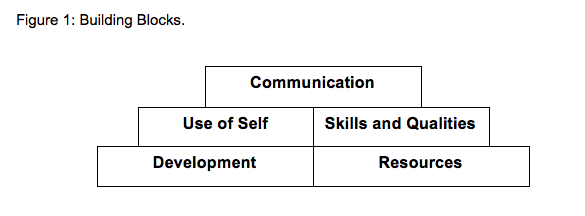
Clearly there was a need to identify adequate resources to underpin possible leadership development. Examples of this were improved communication and how individuals develop their understanding of leadership - action learning sets and development days were suggested as effective ways to take this forward. These views are supported by Tavendale (2010, p 42) whose research evidenced how the use of communities of practice supports the "core business of organisations".
Leadership is a subject that continues to have significant importance and relevance to the social care sector. Leadership is critical, more so now than ever. New ways of partnership working seek to address the future delivery of integrated health and social care across Scotland. This joint delivery of services will require a 'marrying' of cultures and the 'hearts and minds' of those involved. Strong working relationships will be critical in paving the way. Leadership and organisational cultures will therefore have a central part to play in addressing the challenges that lie ahead.
In looking overall at leadership research, evidence suggests that adopting a more diverse perspective to leadership will help us all to reap the most rewards in terms of integration, through a clear vision, productivity, high quality sustainable services and positive outcomes for service users and families.
Perhaps a starting point in establishing such a vision is that, quite simply, everyone has a part to play in leadership. Little will be achieved by holding on to the concept of a one size 'hero' leader. Axelrod (2010, p 39) suggests that a change in the leader's role is essential. Rather than our 'leaders' having the responsibility of finding the 'problem' and the solution, a more useful way forward is for effective leaders to bring people together from all sectors and open up conversations so that "answers can be developed and information sharing is possible".
Clearly, adopting such an inclusive model of leadership opens up an array of possibilities. The underpinning concepts of informal and formal leadership styles will further illuminate leadership possibilities for the wider workforce and reduce the disconnect between what we perceive as 'leadership' and how we recognise and value our own contributions to the entity.
The challenges
In terms of evaluating the possible impacts on practice, a key consideration is how the enthusiasm we generated in the process can be harnessed and pitfalls avoided so that 'leadership' remains live and visible within the daily demands of working lives. In respect of this, findings from the research project, 'Leading Together' (University of Stirling, 2010) shows that potential benefits of leadership at all levels are endangered not only by the demands of our working roles, but also through the constraints of the current financial climate. The reality for workers is that this creates less autonomy for them to explore new skills, knowledge, decision making and creativity, due to the tighter grip on resources managed in a "top down" culture (University of Stirling, 2010: 23).
In reflecting on this issue we can acknowledge that the leadership road shows generated a huge amount of energy and awareness applicable to the leadership agenda. As Heifetz (1994) rightly points out, there are no easy answers to what makes good leadership. However, we discovered through our journey in Angus that the wider the lens that you look through, the richer the source of evolving leadership possibilities there might be. Our findings brought together vital aspects of leadership intertwining positive leadership attributes with aspirational organisational and cultural supports and systems.
What next?
Currently we are looking at a number of initiatives which build on leadership skills and qualities. One such opportunity is through the development of a corporate coaching strategy, which offers an accredited coaching qualification and is accessible to staff across the Council.
A recommendation that also arose from the inquiry proposed the identification of key interest groups, to take forward the development of 'leadership standards' which support leadership growth capabilities. These standards are to be used as a self-evaluation tool to build skills, support practice and will be tested out against performance management frameworks such as the Performance Improvement Model.
Other developments in Angus Council seek to take leadership forward through a new programme, 'Transforming Angus'. This initiative will provide a review of existing development opportunities and supported by a leadership programme, aims to build our organisational capabilities through the review of our performance and service delivery, thereby improving "the overall customer experience". The leadership development programme utilises a blend of learning including e-learning, action learning sets, coaching and workshops. This approach builds on the Angus Council management framework, which supports the philosophy that "all our managers should be leaders - it is their most important role" (Angus Council, 2012).
Certainly, regulatory bodies have a significant role to play in supporting a sustainable social care service. In July 2012 the Scottish Social Services Council (SSSC) launched a new website, Step into Leadership. The website combines a new suite of individual leadership capabilities, building on the Framework for Continuous Learning in Social Services (CLF) (PDF), with resources to support the development of organisational cultures that enable leadership at all levels. A wide range of leadership tools and materials are available through the website.
The Step into Leadership website offers a range of tools as a foundation to explore leadership possibilities and potential and how this might support our leadership capacity to enable cultures and hearts and minds to embrace change. This could provide a forum where we can explore leadership 'safely' to test the entity out, perhaps through leadership communities or the use of action learning sets. We all need to move forward and embrace the ever-evolving change processes or be left behind. We also need to support and evaluate our progress in line with outcomes and timescales and by doing so support sustainable and effective services for the future.
References
Axelrod RH (2010) Terms of engagement. New ways of leading and changing organizations (Second Ed), San Francisco: Berrett-Koehler Publishers, Inc.
SWIA (2010) Improving Social Work in Scotland: A report on SWIA's Performance Inspection Programme 2005-09. Accessed June 2016

